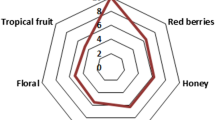Abstract
Volatile and odorous components in two Chinese wines, Moutai and Wuliangye, were partially investigated by direct solvent extraction. Sample extracts were analyzed by gas chromatography/ mass spectrometry and gas chromatography-olfactometry. Fifty-six and thirty-eight compounds were found in Moutai and Wuliangye, respectively, including esters (19, 20), alcohols (8, 7), acids (6, 3), furans (5, 2), acetals (5, 2), phenols (2, 2), ketones (7, 0) and miscellaneous compounds (4, 2). Based on olfactometry, ethyl acetate, furfural and 2-furanmethanol were perceived only in the Moutai whereas diethyl succinate was recognized only in the Wuliangye. However, 1,1-Diethyoxyehtane, ethyl hexanoate, ethyl benzoate and pentanoic acid were found in both wines.
Similar content being viewed by others
Abbreviations
- GC-MS:
-
gas chromatography/mass spectrometry
- GC-O:
-
gas chromatography-olfactometry
References
Arctander S (1969) In Perfume and Flavor Chemicals, Arctander Co., Montclair, NJ, U.S.A.
Budavari, S. (1996) In The Merck Index, (12th ed.), Merck & Co., Rahway, NJ, U.S.A.
Chung HY, Fung PK, and Kim J-S (2005) Aroma impact components in commercial plain sufu. J Agric Food Chem 53, 1684–1691.
Clarke RJ and Bakker J (2004) In Wine Flavor Chemistry, Blackwell Publishing Ltd., Oxford, England.
Defini C, Garci-Moruno E, Pagliara A, and Contiero M (1989) Technological and biological factors causing the production of large amounts of acetic acid by wine yeasts during alcoholic fermentation. In XIII International Symposium Specialized on Yeast, pp. 30–31. Viticulture and Enology Abstracts, Leuven, Belgium.
de Wet P (1978) Odor thresholds and their application to wine flavors studies. Am J Enol Viticult 3, 28–42.
Eglinton JM and Henschke PA (1999) Restarting incomplete fermentations: the effect of high concentration of acetic acid. Aust J Grape Wine Res 52, 71–78.
Etievant PX (1981) Volatile phenol determination in wine. J Agric Food Chem 29, 65–57.
Etievant PX (1991) Wine. In Volatile Compounds in Foods and Beverages, Maarse H (ed.), pp. 483–533. Marcel Dekker Inc., New York, NY, U.S.A.
Fan WL and Qian MC (2006) Characterization of aroma compounds of Chinese “Wuliangye” and “Jiannanchun” liquors by aroma extract dilution analysis. J Agric Food Chem 54, 2695–2704.
Fan WL and Xu Y (2007) The review of the research of aroma compounds in Chinese liquors. Liquor Making 34, 31–37.
Han T (1999) In Zhongguo jiu wen hua tong dian (A Statute of Chinese Wine Culture), Yanbian ren min chu ban she, Beijing, China.
Ho CT (1996) Thermal generation of maillard aromas. In The Maillard Reaction: Consequences for the Chemical and Life Sciences, Ikan R (ed.), pp. 27–53. Wiley Publishing, Chichester, England.
Jackson RS (2000) In Wine science: Principles, Practice, Perception (2nd ed.). Academic Press, San Diego, CA, U.S.A.
Liu J (1992) In Yin jiu de ke xue (Science in Wine Appreciation), Du jiu chu ban she you xian gong si, Taibei, Taiwan.
Lu SP (1994) In Baijiu gong yi xue (White Wine Processing Technology), Zhongguo qing gong ye chu ban she, Beijing, China.
McGovern PE, Zhang J, Tang J, Zhang Z, Hall GR, Moreau RA, Nunez A, Butrym ED, Richards MP, Wang C, Cheng G, Zhao Z, and Wang C (2004) Fermented beverages of pre- and proto-historic China. P Natl Acad Sci USA 01, 17593–17598.
Meilgaard M (1982) Prediction of flavor differences between beers from their chemical composition. J Agric Food Chem 30, 1009–1017.
Nykanen L and Nykanen I (1991) Distilled beverages. In Volatile Compounds in Foods and Beverages, Maarse H (ed.), pp. 547–575. Marcel Dekker, Inc., New York, NY, U.S.A.
Nykanen L, Puputti E and Suomalainen H (2006) Volatiles fatty acids in some brands of whisky, cognac and rum., J Food Sci 33, 88–92.
Pellerin P and O’Neill MA (1998) The interaction of the pectic polysaccharides rhamnogalacturonan II with heavy metals and lanthanides in wines and fruit juices. Analusis 26, 32–38.
Shen YF (2003) Aroma types, style and culture of Baijiu. Liquor Making 30, 1–2.
Sigma-Aldrich (2008) In Flavors and Fragrances; Featuring Naturals and Essential Oils, (International ed.), Sigma-Aldrich Co., Milwaukee, WI, U.S.A.
Simpson RF (1979) Some important aroma compounds of white wine. Food Technol Aust 31, 516–522.
Tressl R, Renner R, and Apetz M (1976) Volatile phenolic components in beer, smoked beer, and sherry. Z Lebensm Unters Forsch 162, 122–155.
van den Dool H and Kratz PD (1963) A generation of the retention index system including linear temperature programmed gas-liquid partition chromatography. J Chromatogr 11, 463–471.
Wang FY, Chen ZF, Wang JH and Wang MH (1998) In Xian dai shi pin fa xiao ji shu (Modern Food Fermentation Technology), Zhongguo Qing Gong Yu Chu Ban She, Beijing, China.
Williams AA (1974) Flavor research and the cider industry. J Inst Brew 80, 455–470.
Wu TX and Liu CZ (2005) Study on the flavoring components of 12 representative kinds of Guizhou liquor. Liquor-making Science & Technology 235, 31–35.
Xu HY (2002) Study on relatively between furfural content and fragrance style of Chinese liquor. Liquor Making 29, 37–38.
Zeng Z (1980) In Zhonggue ming jiu zhi (Record of Famous Chinese Wines), Zhongguo lu you chu ban she, Beijing, China.
Zhang YC and Wu Z (2002) Formation and treating method of bitter in Baijiu. Liquor Making 29, 40.
Zhang YF (1991) In Zhongguo jiu dian (A Statute of Chinese Wine), Guizhou ren min chu ban she, Guiyang, China.
Author information
Authors and Affiliations
Corresponding author
Rights and permissions
About this article
Cite this article
Kim, JS., Kam, S.F. & Chung, H.Y. Comparison of the volatile components in two Chinese wines, Moutai and Wuliangye . J. Korean Soc. Appl. Biol. Chem. 52, 275–282 (2009). https://doi.org/10.3839/jksabc.2009.049
Received:
Accepted:
Issue Date:
DOI: https://doi.org/10.3839/jksabc.2009.049




